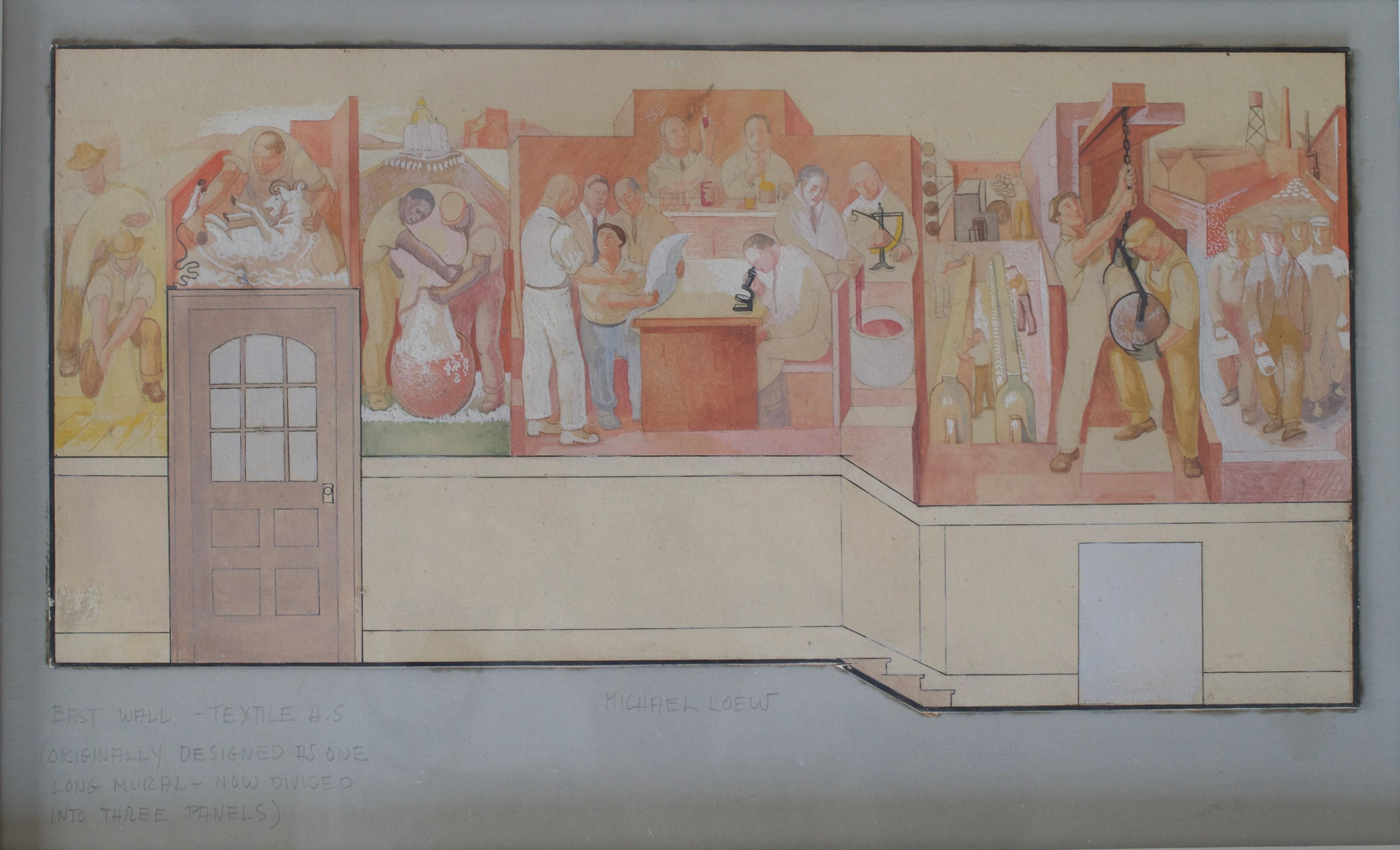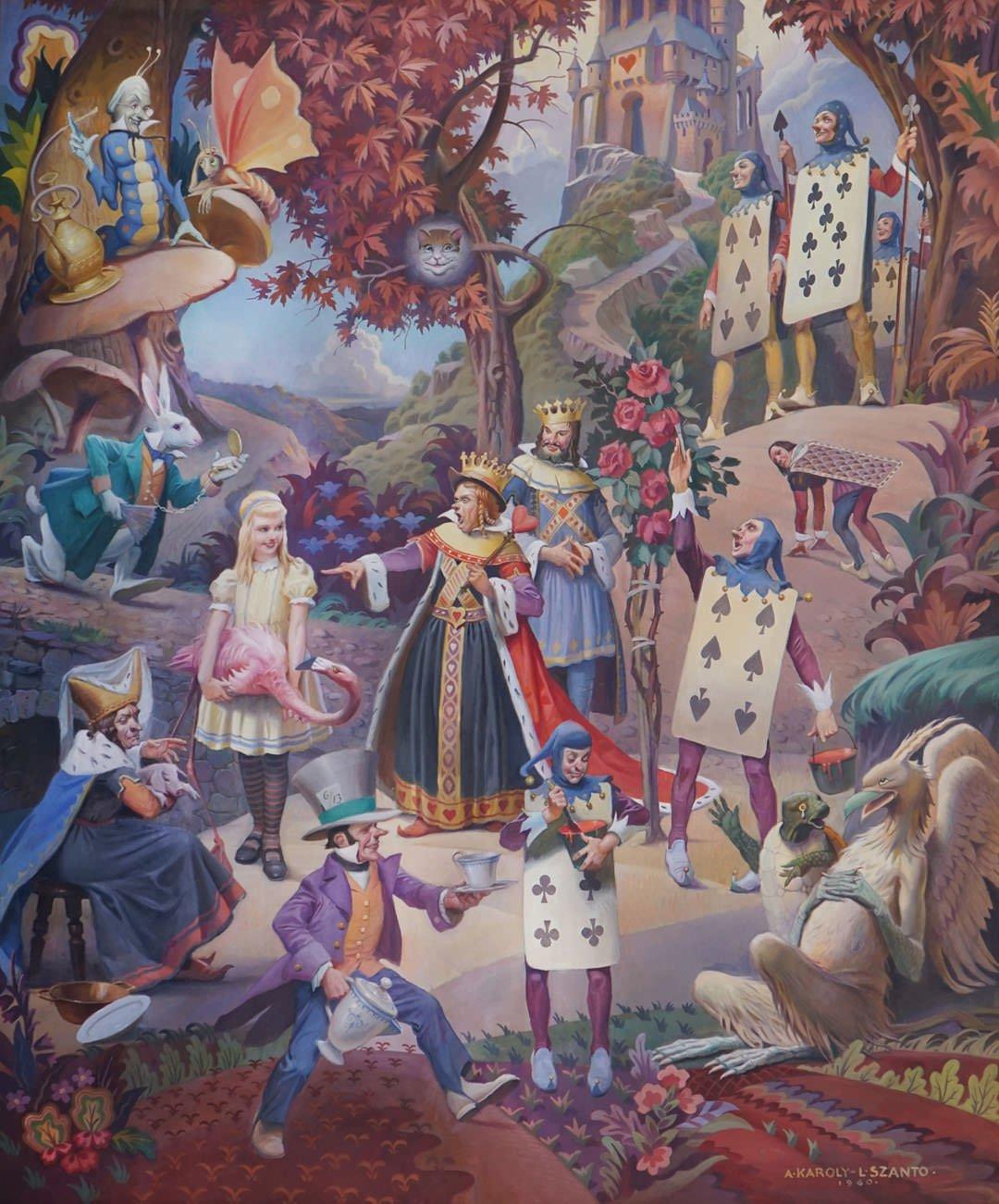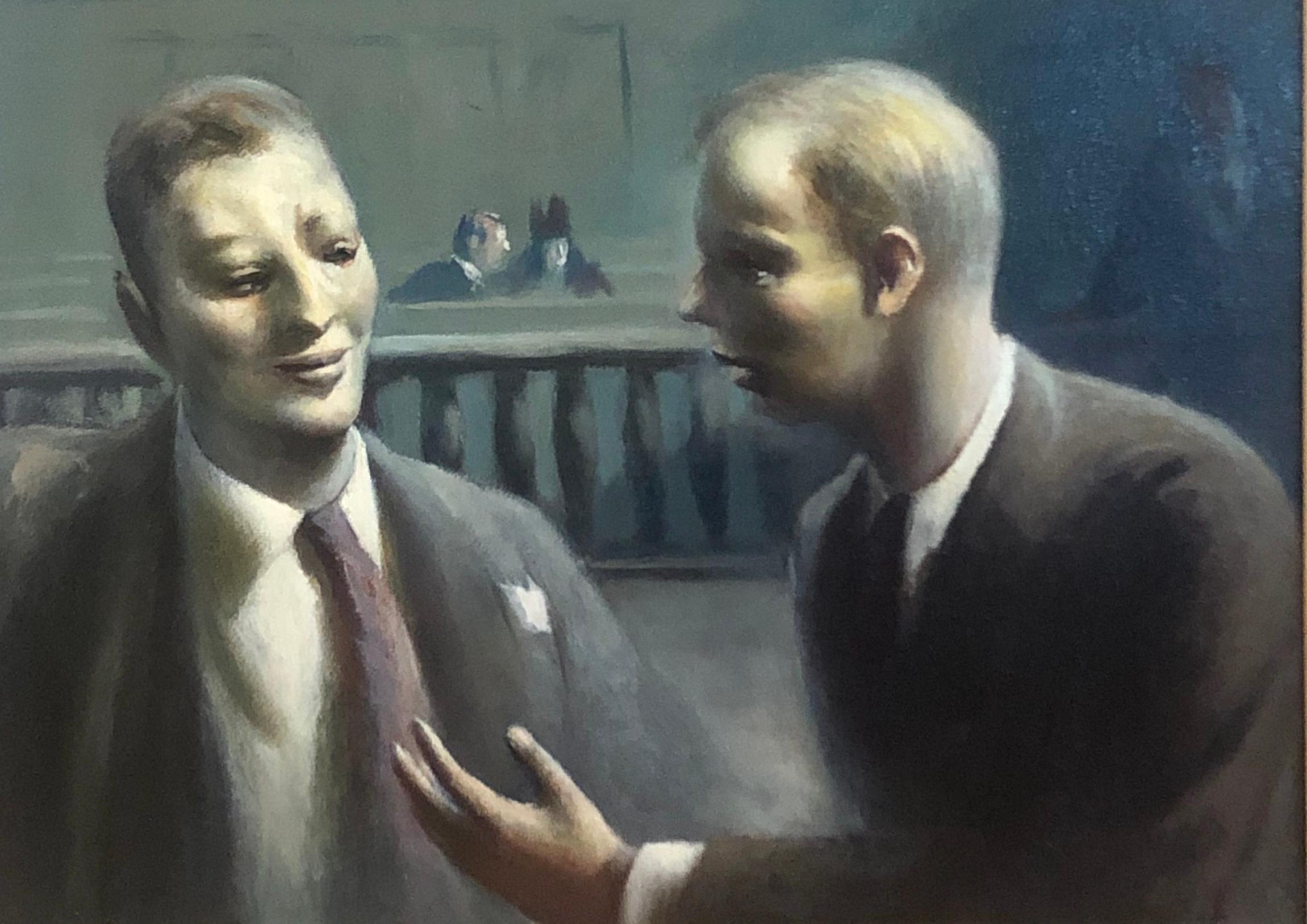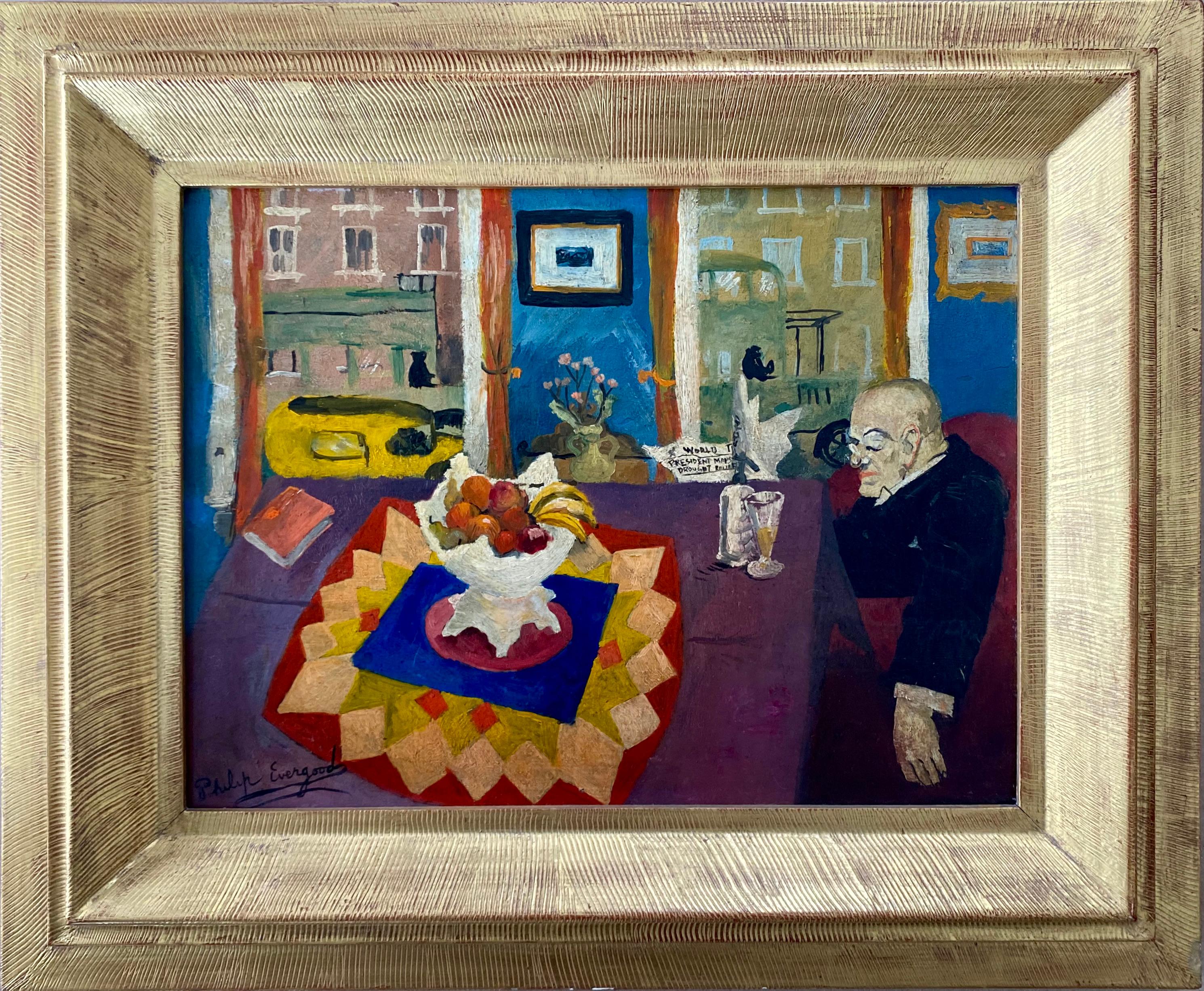Items Similar to San Pedro Post Office: History of Writing Mural South, Preliminary Mural Study
Want more images or videos?
Request additional images or videos from the seller
1 of 5
Edward BibermanSan Pedro Post Office: History of Writing Mural South, Preliminary Mural Studyc. 1936-7
c. 1936-7
About the Item
This mural study is part of our exhibition America Coast to Coast: Artists of the 1930s
San Pedro Post Office: History of Writing Mural South, Preliminary Mural Maquette right panel, 1936-7 mixed media on paper mounted on masonite, 20 x 41 inches (image), 30 x 52 inches (framed); exhibited in Lost Horizons: Mural Dreams of Edward Biberman, Los Angeles County Museum of Art at SPARC's Duron Gallery from May 31 to August 29, 2014; illustrated in i) the catalog for the foregoing p. 22; and ii) (film) Kaufman, Jeffrey, Brush with Life: The Art of Being Edward Biberman, 2007, (DVD release 2010), 85 minutes; provenance estate of the artist; presented in newer frame from the 2014 LACMA/SPARC exhibition
About the Painting
Even before the creation of the WPA and the Treasury Department Section of Fine Arts, Biberman was known as a mural painter, having been selected for inclusion in one of the Museum of Modern Art’s early exhibitions in 1932, Murals by American Painters and Photographers. Around the same time, he also joined the National Society of Mural Painters. While in New York, Biberman lectured on muralism, taught classes on mural techniques and knew, admired, and drew lessons from Los Tres Grandes, the Mexican muralists, Orozco, Rivera, and Siqueiros. By his own reckoning, Biberman competed for seven or eight Federal Government mural projects during the 1930s and early 1940s. In addition to the San Pedro Post Office for which the present works were completed, Biberman submitted designs for the Rincon Annex Post Office (San Francisco), Department of the Interior Building (Washington, DC), the Recorder of Deeds Building (Washington, DC), and the St. Louis Post Office (St. Louis, Missouri), as well as projects in New Jersey and Dallas, Texas. Although Biberman did not win these competitions, he was awarded three Federal Government mural commissions based on being the runner up in several prior efforts. Biberman also served as a member of the jury for the national competition for the Social Security Building in Washington DC where he was able to reconnect with leaders of the Treasury Section of Fine Arts, including Edward Bruce, Edward Beatty Rowan, George Biddle, Holger Cahill and Forbes Watson. Biberman’s completed projects were a wall mural showcasing the history of Los Angeles for the Federal Building in Los Angeles, a ceiling mural for the same building depicting the contributions of four ethnic groups to the development of California, and his best-known mural, Abbott Kinney and the Story of Venice, for the Venice Post Office.
In October, 1936, the Treasury Department Section of Fine Arts announced the competition for the San Pedro California Post Office mural project. The request for submissions noted that the winning artist would receive the handsome sum of $4,900 for the 74-foot long mural. For his entry, Biberman explored the global history of written communication from message sticks through the printing press. In addition to his artistic skills, Biberman was a proficient writer and even better speaker. Words mattered deeply, so Biberman's selection of subject matter is unsurprising, as is his depictions of the contributions of earlier cultures from around the world. Native American peoples had played important parts in his completed mural for the Los Angeles Federal Building, as well as his submissions for the Department of the Interior Building and the Rincon Annex Post Office in San Francisco. Biberman's depiction of less well known forms of written communication such as marked pebbles likely was the result of his interest in historical research and his desire to deeply immerse himself in his mural submissions. "I got very excited by the work" Biberman recalled, "the research, let me say, proved to be one of the most fruitful areas of all of these jobs." Biberman was one of seventy-seven artists to submit designs and his friend and fellow Angelino, Fletcher Martin, won the commission for his designs portraying the history of mail delivery, which can still be seen today.
The Los Angeles County Museum of Art (LACMA), in cooperation with SPAC, hosted a 2014 retrospective of Biberman’s mural-related art at the Duron Gallery, which included all of Biberman's existing designs for the San Pedro Post Office, including this work. This show ran concurrently with LACMA’s other exhibition, Edward Biberman, Abbot Kinney and the Story of Venice, where the Abbott Kinney mural was displayed.
About the Artist
Edward Biberman was born in Philadelphia, the son of Ukrainian Jewish immigrants. His artistic career started at the Pennsylvania Academy of Fine Arts followed by three years of study in Paris, where he associated closely with Calder and Noguchi and exhibited at the Salon d'Automne, Grand Palais, in 1927 and the Salon des Independents in 1929. Upon his return to the United States, Biberman spent time in New York City, where he showed at many of the city’s premier galleries and museums. His works were selected for several of the Museum of Modern Art’s early exhibitions of American artists, including 46 Painters and Sculptors Under the Age of 35 (1930) and Murals by American Painters and Photographers (1932). Hoping to escape the pressures of the New York art world, Biberman moved to Los Angeles in 1936 where he could be close to his family, including his film director brother, Herbert Biberman, and his sister-in-law, the Academy Award winning actress, Gale Sondergaard.
During the course of his long career, Biberman showed at the Salon d’Automne (Paris); Whitney Museum; Metropolitan Museum of Art, Museum of Modern Art, Corcoran Gallery, Los Angeles County Museum of Art (LACMA) and dozens of other museums and galleries across the US and in Europe. Biberman completed three murals for public works projects, including his work Abbot Kinney and the Story of Venice for the Venice Post Office, which was installed for six months at LACMA in 2014. His works are in the permanent collections of more than a dozen museums, including the National Portrait Gallery (of the Smithsonian Institution), Los Angeles County Museum of Art, Museum of Fine Arts, Houston, Butler Institute of American Art, and Pennsylvania Academy of Fine Arts. Several books are dedicated to Biberman’s art, as is a feature length documentary, Brush with Life: The Art of Being Edward Biberman (2007). Biberman’s art has undergone a resurgence of popularity during the past fifteen years with four solo or focused exhibitions, Edward Biberman Revisited (2009), Edward Biberman (2011-12), Lost Horizons: Mural Dreams of Edward Biberman (2014) and Edward Biberman, Abbot Kinney and the Story of Venice (2014), and representation in a number of other exhibitions, such as To Make a World: George Ault and 1940s America at the Smithsonian Institution and other institutions (2011), Pacific Standard Time (2012), Contraption: Rediscovering California Jewish Artists (2018),Black American Portraits (2021) at LACMA, Encounters in American Realism (2022) at The Westmoreland Museum of American Art and Art for the People WPA Paintings from the Dijkstra Collection (2023) at the Crocker Art Museum (Sacramento, CA), Oceanside Museum o f Art (Oceanside, CA) and The Huntington Library, Art Museum and Botanical Gardens (San Marino, CA).
Biberman’s brand of modernism can fairly be divided into four categories 1) precisionist urban scenes of New York and Southern California which celebrate the creations of humanity; 2) portraits which expose not only the historical context, but also the souls, of his subjects; 3) rural landscapes and still life paintings which portray the beauty of America and its flora; and 4) social realist works which explore the struggles, hopes and shortcomings of our society. Regardless of genre, Biberman had a unique sense of structure and color. His figures are at the same time specific and universal. Taken as a whole, Biberman’s body of work presents the viewer with a compelling and often daring vision of 20th century America and its art.
- Creator:Edward Biberman (1904 - 1986)
- Creation Year:c. 1936-7
- Dimensions:Height: 20 in (50.8 cm)Width: 41 in (104.14 cm)Depth: 1 in (2.54 cm)
- More Editions & Sizes:20 x 41Price: $27,500
- Medium:
- Movement & Style:
- Period:
- Condition:
- Gallery Location:Los Angeles, CA
- Reference Number:1stDibs: LU1859213056692
About the Seller
No Reviews Yet
Vetted Seller
These experienced sellers undergo a comprehensive evaluation by our team of in-house experts.
1stDibs seller since 2022
6 sales on 1stDibs
Typical response time: 2 hours
- ShippingRetrieving quote...Ships From: Los Angeles, CA
- Return PolicyA return for this item may be initiated within 3 days of delivery.
More From This SellerView All
- Quarry WorkersLocated in Los Angeles, CAThis painting is part of our exhibition America Coast to Coast: Artists of the 1930s Quarry Workers, c. 1930s, mixed media on board, unsigned, 24 x 24 inches, possibly exhibited at...Category
1930s American Modern Figurative Paintings
MaterialsMixed Media
- What a LifeLocated in Los Angeles, CAWhat a Life, c. 1930, mixed media on board, 18 x 24 inches, signed lower left; titled on label; exhibited at The San Francisco Art Association Fifty-Second Annual Exhibition at the P...Category
1920s American Modern Figurative Paintings
MaterialsMixed Media
- The Landing/Dawn LandingLocated in Los Angeles, CAThis painting is part of our exhibition America Coast to Coast: Artists of the 1940s. The Landing/Dawn Landing, 1944, oil on canvas, signed lower left, 20 x 30, titled verso; exhib...Category
1940s American Modern Paintings
MaterialsCanvas, Oil
- Untitled (Transcendental Composition)By Charles Ragland BunnellLocated in Los Angeles, CAThis work is part of our exhibition - America Coast to Coast: Artists of the 1940s Untitled (Transcendental Composition), oil on board, 1947, oil on board, signed and dated lower r...Category
1940s American Modern Paintings
MaterialsOil, Board
- Riders of Pigeon HillBy Jon CorbinoLocated in Los Angeles, CARiders of Pigeon Hill, c. 1940s, oil on canvas, signed lower right, 24 x 36 inches, label verso with title, artist’s name and address; same information inscribed verso; ex-collection...Category
1940s American Modern Paintings
MaterialsCanvas, Oil
- Untitled (Elevated Platform)Located in Los Angeles, CAThis painting is part of our current exhibition - America Coast to Coast: Artists of the 1940s Untitled (Elevated Platform), 1950, oil on canvas, signed and dated lower right, 30 x...Category
1950s American Modern Paintings
MaterialsCanvas, Oil
You May Also Like
- "Sock Hop" Mid-Century American Modernism WPA Female Artist 20th Century RealismBy Kyra MarkhamLocated in New York, NY"Sock Hop" Mid-Century American Modernism WPA Female Artist 20th Century Realism. 30 x 24 inches. Oil on canvas. Signed on stretcher, c. 1940s. Frame is likely original to the painting. Realist painter-printmaker Kyra Markham...Category
1940s American Modern Figurative Paintings
MaterialsOil, Canvas
- Mural Study 1933 Depression Era Mid-Century WPA Modern American Scene DrawingBy Michael LoewLocated in New York, NYMural Study 1933 Depression Era Mid-Century WPA Modern American Scene Drawing. Study to Scale Mural Sketch for “Evolution of Textile Production” East. All,...Category
1930s American Modern Figurative Paintings
MaterialsBoard, Egg Tempera
- Alice in Wonderland, 1960s Large Mural by Andrew Karoly & Louis SzantoLocated in Beachwood, OHAndrew Karoly (Hungarian-American, 1893-1978)/ Louis Szántó (Hungarian-American, 1889-1965) Alice in Wonderland, 1960 Oil on canvas Signed and dated low...Category
1960s American Modern Figurative Paintings
MaterialsOil
- Seated FigureLocated in Rockland, MESally Michel Biography American, 1902-2003 Sally Michel Avery was an American painter known for her lyrical depictions of everyday life. Though she used techniques and stylized form...Category
1980s American Modern Figurative Paintings
MaterialsOil
- Guy Pene du Bois WPA American Modernism Realism NYC Scene Oil Lawyers in CourtBy Guy Pène Du BoisLocated in New York, NYGuy Pene du Bois' "Two Figures in Courtroom" is a WPA era American scene oil painting created in a realistic style. Modernism at its best The work is framed by Heydenryk. Pène du Bois descended from French immigrants who settled in Louisiana in 1738 and was raised in a Creole household. He was born in 1884 in Brooklyn, NY and first studied with William Merritt Chase at the New York School of Art and later continued his training with Robert Henri. Pène du Bois was greatly impressed with Henri's credo that "real life" was subject matter for art and throughout his life a realist philosophy informed his art as well as his parallel career, art criticism. In 1905, Pène du Bois made his first visit to Paris where he painted scenes of fashionable people in cafes rendered in the dark tonalities and impasto associated with the Ashcan School. By 1920, he had achieved his mature style, which was characterized by stylized, rounded, almost sculptural figures painted with invisible brushstrokes. The subjects of his paintings were often members of society whom he gently satirized. In 1924, Pène du Bois and his wife, Floy, left for France where they would remain until 1930. Returning to America showcases pictures the artist produced after this very productive period abroad. After five years of living in France, Pène du Bois was able to observe American life with fresh eyes. His work becomes more psychologically intense and less satirical. In Girl at Table a slender, blond is shown gazing at a small statue that she holds at arm's distance. The meaning is elusive, but a powerful sense of longing is evoked. Similarly, paintings such as Dramatic Moment and Jane are taut with unresolved dialogue. Both pictures depict mysterious interiors in which a lone woman anxiously awaits the denouement of a suspenseful scene. Other pictures, for example, Chess Tables, Washington Square and Bar, New Orleans, recall Pene du Bois's Ashcan origins in their depiction of urban entertainment. During this period, landscape becomes an important subject for Pène du Bois. Girl Sketching...Category
1930s American Modern Figurative Paintings
MaterialsPaper, Oil, Board
- Philip Evergood American Modernism WPA Social Realism Modern Still Life InteriorBy Philip EvergoodLocated in New York, NYInterior with Man at Table American Modernism WPA Social Realism Modern Painting Philip Evergood (1901 - 1973) Untitled (Interior with Man at ...Category
1930s American Modern Figurative Paintings
MaterialsPanel, Oil




